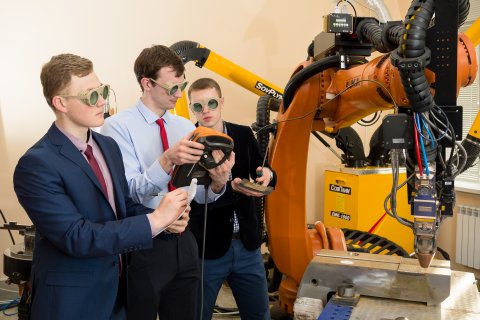In 2017, with the support from SMS Group, a world’s leading manufacturer of metallurgical equipment, South Ural State University opened an international research Laboratory of Mechanics, Laser Processes and Digital Production Technologies, which was headed by Professor of the National Engineering School of Saint-Étienne Philippe Bertrand. The laboratory supervisor on behalf of SUSU, Candidate of Sciences (Engineering), Associate Professor Marina Samodurova shared on the main fields of research.
– Why is the SUSU Laboratory of Mechanics, Laser Processes and Digital Production Technologies unique?
– Our global goal is to introduce this manufacturing at industrial enterprises of the Chelyabinsk Region, all over Russia and around the world. Today we are the technology centre of our partners, SMS Group company. For them, we carry out repair and recovery of machine parts and metallurgical equipment units. They are going to adopt the repair techniques that we use for 14 technology centres around the world. Our laboratory has the most unique equipment for not only research activity, but also for production of industrial samples. For the present moment, not a single engineering university features such a combination of equipment (laser complex and detonation sputtering complex). All universities and research laboratories, working in the sphere of additive technologies, have focused on 3D printing. And we, in our turn, have targeted our research activity at creation of multi-functional and gradient surfaces.
.jpg)
– Why is the development of additive technologies among the most relevant fields in the world’s science today?
– First of all, this is an environmentally friendly manufacture; second, it provides a possibility to manufacture products with high consumer properties and high quality. Often, it is impossible to manufacture the goods produced with our technologies, using some other methods. And what is equally important, we can work with any materials with advanced stress-related properties which are hard to be processed mechanically.
– In which fields research is being conducted at the laboratory?
– Our laboratory is performing research, development and engineering works for such leading corporations in Russia as Transneft, Roscosmos State Corporation, TNK Group of Companies, and more. All the projects are being fulfilled with direct involvement of students and postgraduates. Our main research-and-development fields include: creation of multi-functional and gradient coatings using the method of laser cladding; laser synthesis (growing) of three-dimensional goods; thermal strengthening of surface; repair and restoration of worn-out surfaces of parts in machinery and equipment. Besides that we’re creating new combinations of materials, which are characterized with enhanced stress-related properties and which will find application in space, aviation, military industries, and power sector.
– What are the most significant results of the laboratory activity as of today?
– We’re currently doing some serious work for Roscosmos State Corporation and acting as a partner for NPO Kompozit, Korolyov. The NPO Kompozit workers manufactured a blank part for us, which had been produced using the method of selective laser sintering. Our task was to “grow” a large-dimension element made of titanium alloy on this blank part using the laser cladding method. We developed a technology, which allowed to combine two different methods of manufacturing a part from titanium alloys.
Moreover, recently, we’ve been dealing with difficult-to-form materials. These have such properties as elasticity, high-temperature stability, and enhanced hardness. But the process of pressure treatment of such materials is very labour-intensive, that is why special equipment and production tooling are required, as well as special production methods. We have patented a design for the tooling equipment and created a simulation of the production process, which allows to manufacture small goods made of new difficult-to-form materials with targeted properties. Based on the results of the previous research studies, we are simulating the process of treatment for the new materials.

– What are the prospects of the laboratory development?
– In December 2018, we have acquired new equipment, and therefore, new possibilities for using our technologies. We intend to combine 2 technologies, detonation sputtering and laser cladding, while solving serious tasks for major corporations from the aviation, space, oil-and-gas refining, and metallurgy industries. We’re also planning on continuing our work on difficult-to-form materials with high-temperature stability, which include not only graphite-reinforced plastics, but also molybdenum and tungsten alloys. Graphite-reinforced plastics is a promising material for manufacturing spaceships, military and civil aviation, as well as for nuclear industry. Our task as process engineers is not to impair the properties of the material, but to produce of small item of maximum density.
– On June 1st, within the frameworks of the International Scientific Council, the results of work by the international research laboratories were presented. What recommendations were given by the SUSU ISC members to the Laboratory of Mechanics, Laser Processes and Digital Production Technologies on its development?
– The International Scientific Council members noted the positive experience on the development of our laboratory. They highlighted the prospects of developing the scientific research work in this field. We were recommended to present information on the works, that have been completed and are being currently carried out by our laboratory, in the form of scientific reports at the coming international scientific forums, and in the form of publications in highly rated journals.
It was especially noted that the Department of Machines and Processes of Pressure Metal Working opened a Master’s programme on Additive Technologies within project-based learning. It is important for us since for these technologies to be implemented in production, the qualified personnel is needed more than ever.




